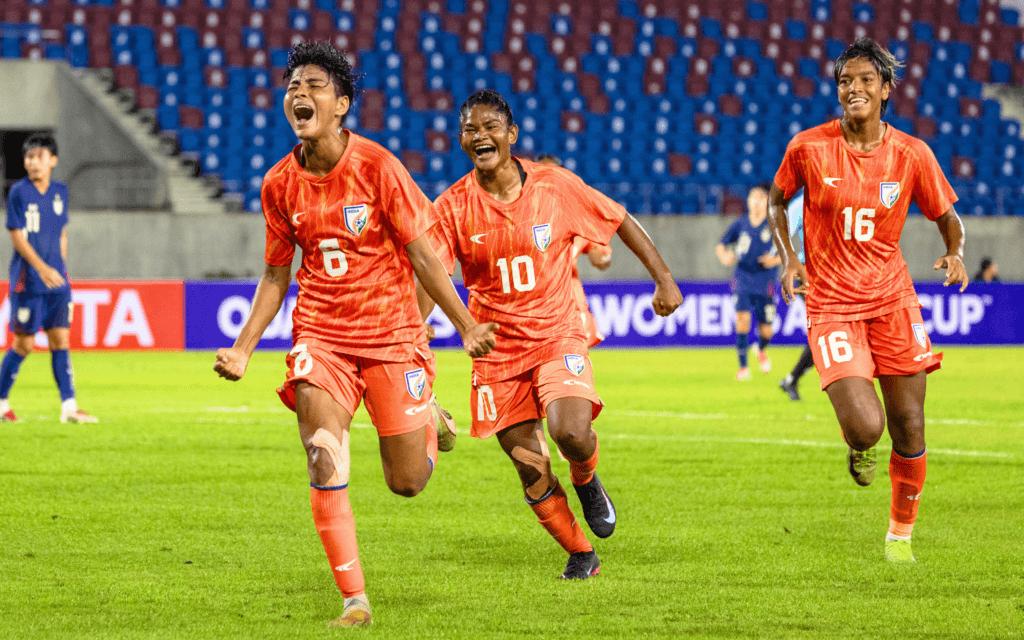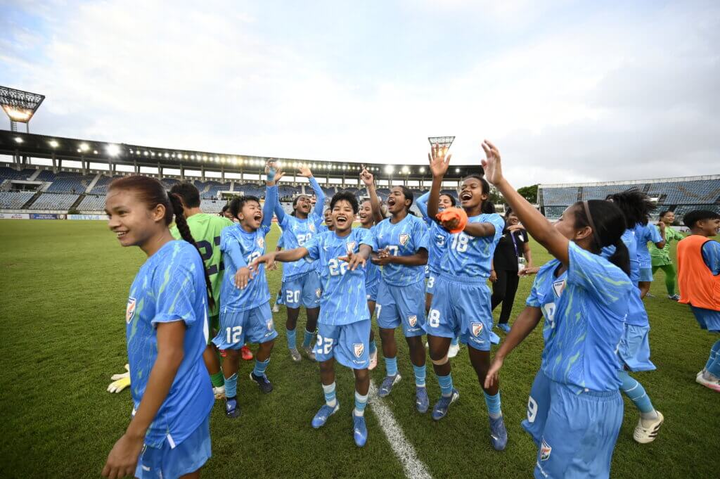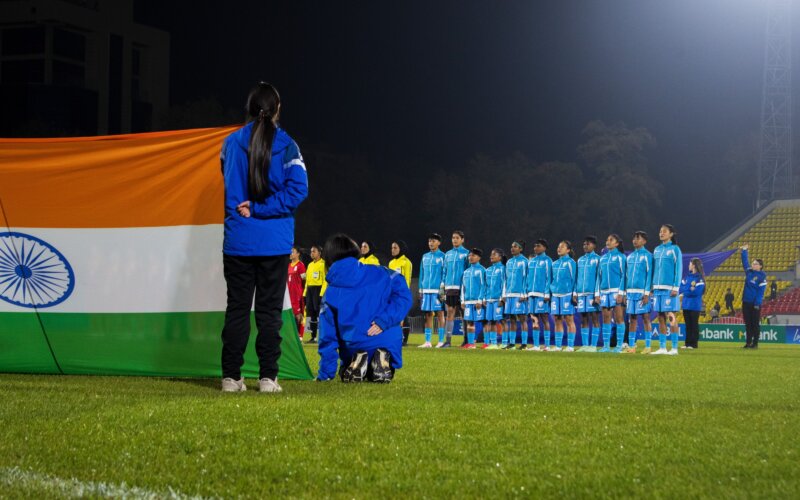Indian women’s football has experienced several false dawns but 2025 stands apart as the year the sun truly rose. For the first time in history, India’s Senior, U20, and U17 women’s teams all qualified on merit for their respective AFC Asian Cup 2026 tournaments.
Between June and October, across three continents and 15 tournament matches, India’s women’s football program delivered a collective record of 13 wins, 1 draw, and just 1 loss, scoring 63 goals and conceding only seven. It wasn’t just a statistical streak it was the unveiling of a new identity: organized, fearless, and continental in ambition.
Breaking the 23-Year Barrier: Senior Team’s Return to the Asian Cup
When the Blue Tigresses defeated hosts Thailand 2–1 in Chiang Mai to top their group and qualify for the 2026 AFC Women’s Asian Cup (Australia), it ended a 23-year drought. For the first time since 2003, India reached the tournament on merit, not by hosting or relying on regional dominance.
Led by coach Crispin Chettri, India’s campaign was a masterclass in tactical discipline and composure under pressure. The team opened with a record-breaking 13–0 demolition of Mongolia, followed by clinical wins over Timor-Leste (4–0) and Iraq (5–0). But it was the final against Thailand a team ranked 24 places higher that defined India’s campaign.
Midfielder Sangita Basfore scored twice a sharp volley in the 28th minute and a composed finish in the 74th — to secure a famous 2–1 win. India finished with a perfect record (4W, 0D, 0L), scoring 24 goals and conceding only once. The team’s FIFA ranking climbed to 63, their highest in two years, signaling a genuine resurgence on the continental stage.
“We cannot rely on long camps or easy friendlies anymore,” said Chettri. “Our players must stay match-fit through a longer, stronger Indian Women’s League.”
That statement defines the next step: transforming international success into sustainable domestic competitiveness.
The U20 Revolution: Ending a 20-Year Wait
If the senior team reclaimed its past, the U20 side built the foundation for the future. In Yangon, Myanmar, the Young Tigresses qualified for the AFC U20 Women’s Asian Cup Thailand 2026, ending a 20-year absence from the continental event. The campaign opened with a tense 0–0 draw against Indonesia, but India soon found rhythm thrashing Turkmenistan 7–0 and then defeating hosts Myanmar 1–0, thanks to a decisive 27th-minute goal from Pooja.
Captain Shubhangi Singh, with her commanding presence in defense and leadership on the ball, was the heartbeat of the squad. Meanwhile, goalkeeper Monalisha Devi, who was also part of the senior qualifying squad, kept three consecutive clean sheets. This defensive solidity three matches, zero goals conceded showcased a level of organization and tactical awareness previously unseen in India’s youth setups.
U17 Young Tigresses: The Future Arrives
The youngest group of the three India’s U17 women’s team delivered arguably the most emotionally resonant story. Under Swedish coach Joakim Alexandersson, they became the first Indian U17 side ever to qualify on merit for the AFC Asian Cup.
The campaign began with total regional dominance at the SAFF U17 Championship in Bhutan, where India won five matches with a +27 goal difference before a 3–4 loss to Bangladesh in the final. That defeat, Alexandersson later said, “was the best lesson before Kyrgyzstan.”
Just weeks later, in Bishkek, that lesson paid off.
India defeated the hosts Kyrgyz Republic 2–1 and then came from behind to beat Uzbekistan 2–1, a victory that sealed their place at the continental event. Captain Julan Nongmaithem and striker Anushka Kumari led the charge, while substitute Thandamoni Baskey produced a game-changing cameo against Uzbekistan scoring the equalizer and assisting the winner.
Historic Night in Bishkek: Indian U17 Women Qualify for AFC Asian Cup After 21 Years
That comeback wasn’t just a football result; it was a statement about composure, belief, and adaptability under pressure qualities India had lacked for decades.
What ties these achievements together is philosophical consistency. Since 2023, the All India Football Federation (AIFF) has implemented a unified developmental pathway, aligning the U17, U20, and Senior teams under complementary systems of play. The cornerstone of this approach is Joakim Alexandersson, whose emphasis on psychology, tactical flexibility, and positive reinforcement has shaped the country’s new footballing identity.
“It took longer to build trust here than in Europe,” Alexandersson admits, “but once players understood that mistakes are part of progress, everything changed.”
By creating a seamless bridge between youth and senior levels, the AIFF has ensured that players like Anushka Kumari (14) and Thandamoni Baskey (15) are no longer isolated talents they are pipeline products, destined for senior integration by 2030.
The Numbers That Define the Year
Across 15 critical matches:
- 13 Wins | 1 Draw | 1 Loss
- Goals Scored: 63
- Goals Conceded: 7
- Goal Ratio: 9:1
Those figures reflect not just dominance, but depth a sign that India’s women’s football ecosystem finally has balance between talent, coaching, and mentality.
The IWL Imperative: Building a Competitive Base
Every coach and player in India’s women’s setup echoes one refrain the Indian Women’s League (IWL) must expand. Currently limited in length and participation, the IWL cannot sustain players’ match fitness year-round. Coach Chettri has called for immediate expansion to 12 teams with a longer calendar to provide consistent competitive exposure.
Without this, the hard-won international momentum risks stalling. The AIFF must now translate success into structure mandating professional licensing for women’s teams and ensuring equal access to facilities and visibility. Senior captain Ashalata Devi noted the improved facilities GPS trackers, better pitches, proper travel but also pointed to a missing piece, representation.
Institutional parity, she believes, will ensure long-term player welfare and create a system that understands both the physical and psychological dimensions of female athletes. Qualification is only the beginning. At the 2026 AFC Women’s Asian Cup, India will share Group C with Japan (7th world rank), Vietnam (37th), and Chinese Taipei (42nd) all superior on paper. Competing, not just participating, will demand new heights of tactical sophistication and endurance.
To bridge that gap, the AIFF must:
- Expand and professionalize the IWL, making it the cornerstone of match fitness and scouting.
- Institutionalize high-intensity exposure, arranging regular friendlies with top Asian sides like Vietnam, Uzbekistan, or even Japan.
- Embed coaching continuity, formalize Alexandersson’s developmental model into AIFF’s official coaching curriculum.
- Protect the pipeline, ensure transition opportunities for U17 and U20 stars to avoid stagnation between age levels.
India’s women’s football program has finally broken free of its cycle of fleeting promise.
The triple qualification Senior, U20, and U17 is not an anomaly; it’s the result of planning, patience, and belief. The next frontier lies in sustaining it: through a stronger domestic league, continued exposure, and a system that prioritizes both performance and protection.
2025, then, will be remembered not just as the year India qualified, but as the year India arrived with three generations of women, united by one purpose: to compete, to believe, and to belong among Asia’s best.
How useful was this post?
Click on a star to rate it!
Average rating 5 / 5. Vote count: 2
No votes so far! Be the first to rate this post.









